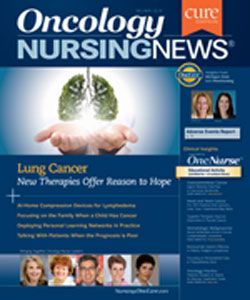Compression Devices Improve Life With Lymphedema in More Ways Than One
Patients with lymphedema may significantly reduce their chances of skin infection and lower their healthcare costs with an advanced pneumatic compression device (APCD), a newly published study has found.
Sheila Ridner, PhD, RN, FAAN

Sheila Ridner, PhD, RN, FAAN
Patients with lymphedema may significantly reduce their chances of skin infection and lower their healthcare costs with an advanced pneumatic compression device (APCD), a newly published study has found.
Researchers analyzed 718 patients with cancer-related and non-cancer—related lymphedema who used an APCD at home over a 5-year period. They evaluated clinical events and associated costs for a 12-month period prior to and during a 12-month period of treatment. The APCD used for the study was the Flexitouch System, developed by Tactile Medical.
Use of the APCD was associated with a nearly 80% reduction in rate of cellulitis episodes among patients with cancer-related lymphedema (from 21.1% to 4.5% [P < .001]) and a 75% reduction in patients with non-cancer lymphedema (from 28.8% to 7.3% [P < .001]).
Additionally, the total lymphedema-related costs per patient in the cancer cohort were reduced by 37% (from $2597 to $1642 [P = .002]). The decline in costs for the non-cancer cohort was 36% (from $2937 to $1883 [P = .007]).
“Based on patient reports from my work, patients have told me that they perceived that they had benefits of the device, so we thought that we would find something, but these are much more profound results than what we were expecting in terms of reduction results,” noted study coauthor Sheila Ridner, PhD, RN, FAAN, the Martha Rivers Ingram Professor of Nursing at Vanderbilt University School of Nursing.
Fellow researcher Alan T. Hirsch, MD, professor of medicine, epidemiology, and community health in the Cardiovascular Division at the University of Minnesota Medical School and chief medical officer of Tactile Medical, added that he was also surprised by the results.
“I think to our knowledge this is the very first lymphedema study that really looked at the health and economic impact. Even though we knew pumps were beneficial before the study, it was very gratifying to have such a good study where people clearly feel better and it costs less,” he said.
Patients with cancer can be at a particular risk of developing lymphedema if their cancer cells block lymphatic vessels or if their lymph nodes are removed or damaged during surgery or treatment. The condition causes painful tissue swelling, which if left untreated, puts the patient at high risk of infection and cellulitis episodes and can result in loss of function and reduced quality of life.
Complete decongestive therapy (CDT), which consists of manual lymphatic drainage, compression techniques, and self-care, is commonly used to treat patients newly diagnosed with lymphedema.
However, because lymphedema can be chronic and progressive, ongoing travel to a clinic may not be feasible for some patients. Additionally, patients with arthritis or those who cannot reach their swollen areas may not be physically able to manually massage themselves or wear standard compression garments.
The garments of an APCD inflate over swollen areas caused by lymphedema and help transport the fluid into or along the lymphatic vessels so that they leave the limb, mimicking the massage motion that would be performed by a physical therapist.
During the follow-up period of the study, patients with cancer-related lymphedema had a 29% reduction in outpatient visits from 58.6% to 41.4% (P < .001). The results were similar in the non-cancer-related group with a 40% decline in outpatient visits (52.6% to 31.4%, P < .001).
The reduction in visits was reflected in medical costs as well. In the cancer-related cohort, outpatient hospital costs were reduced from $1517 to $694 (P < .001) and physical occupational therapy—related costs dipped from $287 to $145 (P = .03), about a 50% reduction. Clinic visit costs also declined from $468 to $274 (P = .01).
The cost reduction results were similar for the non-cancer cohort, which had a 65% reduction in outpatient hospital costs and a 50% decline in outpatient therapy—related costs.
“As a nurse, another thing that you learn when looking at things like reduction in outpatient visits, reductions in emergency room visits, and reductions in actual episodes of care with a professional caregiver is that quality of life is improved,” Ridner said. “Patients who are spending less time being ill with complications from lymphedema physically feel better. And from a quality of life perspective, they feel better when they’re not tied up with trips to the doctor and trips to the lymphedema therapists but can take care of themselves at home.”
Pneumatic compression devices (PCD) are currently covered by nearly all insurance companies in the United States for patients who meet the required criteria, and reimbursement rates for PCDs can range from $700 to around $5000 depending on the type of device, according to Maggie Thompson, RN, BS, vice president, Payer Relations and Government Affairs at Tactile Medical.
However, Medicare contractors who administer durable medical equipment benefits have released a new Local Coverage Determination, expected to be implemented December 1, which would limit access to PCDs only to those whose condition is chronic and severe with irreversible adverse effects.
“The implications for patients with lymphedema are actually pretty severe, because Medicare is narrowing the criteria that have to be met for people to be covered to use these devices. For advanced devices, they’re requiring total failure of all other devices,” Ridner said.
“This is one self-care intervention that nurses can really help patients manage very well. If we really want to cut costs in healthcare, using nurse practitioners and nurses to more adequately manage symptoms to reduce burden would seem to be something worth considering.”
Karaca-Mandic P, Hirsch AT, Rockson SG, et al. The cutaneous, net clinical, and health economic benefits of advanced pneumatic compression devices in patients with lymphedema. JAMA Dermatol. 2015;151(11):1187-1193.

Innovative Program Reduces Nurse Turnover and Fosters Development
Published: September 12th 2024 | Updated: September 12th 2024The US Oncology Network (The Network) has developed one of the most comprehensive programs in the nation to support the professional development and retention of new oncology nurses.


